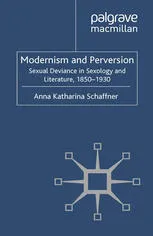Modernism and Perversion: Sexual Deviance in Sexology and Literature, 1850–1930
4.5
Reviews from our users

You Can Ask your questions from this book's AI after Login
Each download or ask from book AI costs 2 points. To earn more free points, please visit the Points Guide Page and complete some valuable actions.Modernism and Perversion: Sexual Deviance in Sexology and Literature, 1850–1930
Modernism and Perversion: Sexual Deviance in Sexology and Literature, 1850–1930 by Anna Katharina Schaffner is a seminal work that explores the intricate connections between sexology and literary modernism during a transformative period in cultural history. This book delves into how scientific discourses on sexual deviance influenced and, in turn, were shaped by the avant-garde literature of the late nineteenth and early twentieth centuries. It offers a profound analysis of the cultural anxieties and intellectual debates surrounding human sexuality, deviancy, and morality during an era characterized by radical shifts in societal norms.
Detailed Summary
The book analyzes the intersection of sexuality, science, and literature between 1850 and 1930, a period marked by profound cultural and intellectual change. Anna Katharina Schaffner examines how sexologists, such as Richard von Krafft-Ebing, Sigmund Freud, and Havelock Ellis, defined and categorized sexual deviance, including behaviors and identities that deviated from heteronormative standards. These early works in sexology laid the groundwork for understanding human sexuality, but they also reflected societal prejudices and regulatory mechanisms designed to control perceived moral transgressions.
Meanwhile, this era witnessed the emergence of modernist writers such as James Joyce, D.H. Lawrence, Virginia Woolf, and Marcel Proust, whose literary works often tackled themes of sexual identity and transgression in revolutionary ways. Schaffner argues that there was a dynamic exchange between the nascent field of sexology and avant-garde literature, whereby modernist writers both drew upon and challenged the parameters established by sexologists. These literary figures pushed boundaries not only in content but also in form, using experimental techniques to disrupt conventional narratives and explore the fragmented nature of human desire and identity.
The book thoroughly investigates how literary modernism questioned normative frameworks, using sexuality as a lens to explore broader societal taboos and cultural shifts. By scrutinizing texts that often provoked outrage and censorship, Schaffner unveils the complex ways art interacted with scientific theories to aid in understanding the fluid and multifaceted nature of human sexuality during this pivotal historical moment.
Key Takeaways
- Sexology in the late nineteenth and early twentieth centuries introduced critical frameworks for categorizing human sexuality, which were simultaneously rigid and open to questioning by cultural movements.
- Modernist literature engaged deeply with concepts of sexual deviance, challenging the dichotomy between normal and abnormal, and embracing the complexity of sexual identity and desire.
- The period of 1850–1930 reveals the reciprocal influence between scientific disciplines and artistic expression, underscoring how cultural products often shape and redefine intellectual paradigms.
- By analyzing both sexological texts and modernist works, the book provides a comprehensive view of how sexuality was conceptualized and represented during this transformative period.
- Artistic innovation and scientific inquiry often shared a common goal: the unveiling of suppressed truths about human existence and the interrogation of cultural norms.
Famous Quotes from the Book
"Both sexology and literature sought to uncover hidden truths about human sexuality, albeit through radically different methods—one analytical, the other imaginative."
"The destabilization of normative constructs in modernist literature offered a symbolic liberation from the rigid taxonomies imposed by early sexology."
"Sexual deviance, rather than being purely pathologized, became a site of artistic inquiry and a metaphor for exploring broader epistemological ruptures."
Why This Book Matters
Modernism and Perversion is not merely an academic text; it is an essential lens through which readers can better understand the profound cultural shifts that occurred from the Victorian era to the early twentieth century. By illuminating the symbiotic relationship between sexology and literary modernism, this book sheds light on how science and art mutually influenced one another during a time of significant change in attitudes toward sexuality.
It also holds contemporary relevance by examining how cultural narratives around sexual identity and morality evolve. In an era that continues to grapple with questions of inclusivity, representation, and the fluidity of human sexuality, Schaffner’s work provides historical context for ongoing debates. The book serves as a bridge between the past and the present, urging readers to investigate how intellectual and artistic movements shape societal perceptions of human desire and identity.
Whether you’re a scholar of modernist literature, a student of sexology’s history, or a curious reader interested in the interplay between science and art, Modernism and Perversion offers invaluable insights into a fascinating era. Its interdisciplinary approach ensures that it appeals to a wide range of audiences, fostering deeper understanding of the forces that shaped modern sexual discourse.
Free Direct Download
You Can Download this book after Login
Accessing books through legal platforms and public libraries not only supports the rights of authors and publishers but also contributes to the sustainability of reading culture. Before downloading, please take a moment to consider these options.
Find this book on other platforms:
WorldCat helps you find books in libraries worldwide.
See ratings, reviews, and discussions on Goodreads.
Find and buy rare or used books on AbeBooks.
1188
بازدید4.5
امتیاز50
نظر98%
رضایتReviews:
4.5
Based on 0 users review
"کیفیت چاپ عالی بود، خیلی راضیام"
Questions & Answers
Ask questions about this book or help others by answering
No questions yet. Be the first to ask!


